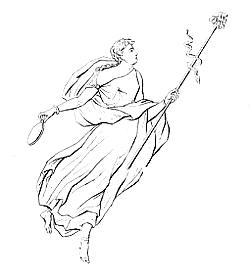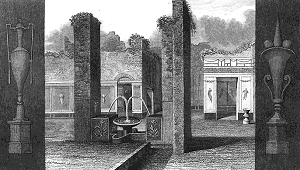Chapter IX - Fullonica |
|
The Fullonica is situated just behind the back wall of the house of the Poet, and has a door, like it, opening into the vicus, as well as a great entrance from the street, which passes under the arch of Tiberius Caligula or Augustus, near the Temple of Fortune. That street is now called the Street of Mercury, or of the Mercuries, from the number of paintings of that divinity which it exhibits. Before we enter that street, however, it will be necessary to notice the prolongation of the Street of the thermae, which passes along the north flank of the Temple of Fortune, and in which, at the present moment, February, 1829, the excavations are continuing. It is very probable that this street may be that branch of the Via Domitia which ran to Salernum, and leads to the gate commonly called that of Nola ; and the frequent and deep traces of wheels at the point now excavating prove the street to have been a much-frequented passage through the city. |
Between the house of the Poet and the triumphal arch, several rooms bear the appearance of having served as places for refreshment for those who used the baths. Beyond the arch, the first pier or termination of a massive stone wall of great blocks was ornamented with a most interesting painting of a galley with its equipage, now defaced, and, beyond this, is the entrance to a house now called by the names of Ceres and Bacchus, and of the Bacchanti, from paintings of these divinities in the atrium. The painting of the galley had, for some time, acquired the name of Casa del Naviglio for the house.
|
In the entrance, pretty groups of vases are painted,
one of which is given in plate XII. On the right is a
sort of recess, not observed in other houses, where a
slave or porter might have been stationed. |
|

Plate 62 - Commentary |

Plate 83 |
It is so different in its effect from other houses of
Pompeii, that a view of it has been selected for plate LXII,
by which a correct idea of its present state may be obtained.
In a little room, on the right of the atrium, were
found, leaning against the wall, several iron fellies of
large wheels, so exactly similar to those of modern
construction, that the paintings lately discovered were
scarcely necessary to convince us that, in the first century
of our aera, wheels were no longer of the antiquated form
represented on vases and marbles with four spokes, but, as
nearly as possible, resembled those now used in Europe.
The House of Ceres was evidently the dwelling of a person of
consequence, and is connected, by means of the passage, or
faux, on the right of the triclinium (Vide
plan, Plate
LX), with what may have originally been another
habitation, which might have been a new acquisition, as it
was evidently undergoing a repair, and receiving fresh
embellishments at the moment when every thing was interrupted
by the final catastrophe. This second division of the house
consists only of the remains of a portico, with a large
central room and two small chambers, occupying one side of a
square court, in the centre of which is a fixed
triclinium, or raised bench of masonry, suited to the
reception of three sofas or beds, with a table in the
centre.
The walls of this court or garden, or whatever it might have
been, seem not to have been yet covered with plaster. The
entrance is from the Street of Mercure.
On the piers of the houses near that of Ceres and Bacchus,
are found several inscriptions, opposite the northern flank
of the Temple of Fortune.
C. LOLLIVM FVSCVM
ET. POPIDIVM. SECVNDVM
V. B. O. V. F.
M. CERRINIVM. VAEIVM. R. D.
AED. OR.
This is in red characters. The proprietor seems to invoke the favour O. V. F. of C. Lollius Fuscus and Popidius Secundus, good men V. B., and of M. Cerrinius Veius the Aedile, worthy of the Republic, or R. D. Another has
PANSAM. AED. OR
AT POPIDIVM
C. CALVENTIVM. II. VIR
SITTIVM. MAGNVM. OR
M. G. M.
AED.
This street is much worn by carriages beyond the House of
Ceres and the Temple of Fortune, and, from its direction,
probably follows almost a direct line to the gate commonly
called that of Nola, but which, perhaps, points more directly
to Sarno, where the fine sources of the river must always
have collected a population.
The arch which forms the entrance into the street, now called
Via dei Mercurii, or the Street of the Mercuries, from the
many repetitions of the figures of Mercury or his attributes,
may be supposed, from the fragments of a column and a capital
lying near it, to have been ornamented with Doric columns,
and fountains which threw up water in jets, as may be
imagined from the pipes yet distinguishable in the masonry.
The whole was, of course, covered with marble, because every
thing of the kind at Pompeii was decorated with that
material. Near the arch was painted a fragment, supposed to
imply Virum Amplissimum, etc
V. A. H. A.
In red is
AED. 0. V. F. HYPSAEVM
In black
QVINQ. D. R. P.
C. IVLIVM. POLIBIVM. D. I. D.
O. V. F.
M. LVCRETIVM. PRO...
A person of the name of M. Plautius Hypsaeus, who was
consul in the year 125 before our aera, was, possibly, the
subject of this inscription. It is always an agreeable
circumstance to meet with a memorial of any person known in
history.
The same name is repeated in another place : L. VERANIVM
HYPSAEVM.
In this street was an inscription of the Pomarii or
Fruit-sellers ; and it seems that there must have been a
fraternity of almost every trade or profession. Bonucci has
collected several of these, and of such as complimented the
aedile or protector of their shops.
POSTUMIUM PROBUM. AED. PHOTINUS. ROG.
FER TUNNUM.
This incorrect inscription is a compliment from Photinus,
a seller of tunny, to Postumius.
Marcellinum aedilem Lignarii et Plostarii rogant ut faveat.
The Woodmen and Carmen invoke the favour of Marcellinus the
aedile.
M. Cerrinium aed. Salinienses rog. The Saltworkers invoke the
aedile Marcus Cerrinius.
A. Vettium aed. Saccarii rog. The Porters of Sacks invoke
Aulus Vettius the aedile.
C. Cuspium Pansam aed. Aurifices universi rog. The
Corporation of Goldsmiths invoke the aedile C. Pansa.
C. Jul. Polybium II. V. Muliones. The Muleteers salute the
Duumvir Caius Julius Polybius.
Pilicrepi facite. Applaud ye who play at ball.
Fornacator Secundo aed. The Attendant on the Furnace invokes
Secundus the aedile.
Paquio Duumv. I. D. Venerei. The Venerei salute the Judge
Paquius the Duumvir.
After an advertisement for a venatio are the words «O
Procurator felicitas». These inscriptions are copied
from Bonucci, who collected them on the walls of divers
edifices. There are also inscriptions of the Isiaci
Universi.
In this street was the following Oscan inscription :
 |
in which the word emens seems clear, but the
remainder is nearly effaced.
It is further curious to observe, that on the great and
antique stones which form the wall of the house of Bacchus
and Ceres toward this street, are to be traced
M. C. V. R. DORP
D. R. P. SVA PIVM IVS
cut into the blocks. The writer was D. R., worthy of the
republic, but perhaps he had erected the wall at his own
expense - Pecunia Sua.
Among others, is on the left
CASELLIVM. MARCELLVM AED. OPTIMOS. COLLECAS.
Near the arch
L. MARCELLVM AED
ALBVCIVM
OVF
The O. V. F., orat ut faveat, is in a species of
cipher.
The street is among the widest yet opened in the city ; and
as two great roads passed through Pompeii, that called the
Popidiana to Nola, and that branch of the Via Domitia which
ran through Nuceria, it is not improbable that, by pursuing
the excavation, the street of the Mercuries will be found to
be the Via Popidiana itself. This, however, is on the
supposition that the gate of Isis, now commonly called that
of Nola, did not lead to that city, which does not in fact
lie in that direction.
About six or seven shops occur between the arch of Caligula
and the great entrance of the fullonica. Vide the Plan,
Plate LX.
The court of the fullonica is forty-five feet long and
twenty-two feet six inches wide. On each side were fixe piers
instead of columns, which may have been united by architraves
or timbers, for none remain. It seems, however, from several
columns which must have fallen from above, that two ranges
existed. On the north side, between the piers, is the
beautiful marble mouth, of a well, prettily ornamented with
triglyphs. In the portico is lying a large circular vase, or
jar, which lias been broken across the centre horizontally,
and is so singularly and carefully sewed together with wire
of metal, that such vases must have borne a high price at
Pompeii, though of the most common red clay.
There seems to have been a porter's lodge, or something
equivalent, at the entry. Vide plan.
The west end of the court is entirely occupied by four large
square vessels corresponding in use to what we call coppers,
but built of solid masonry and lined with stucco. They are
above seven feet deep, and it required a little flight of
steps to enable the fuller to look into them. The water seems
to have passed from one into the other in succession ; and
the portico, on the north side, retains the vestiges of six
or seven smaller basins, in which lighter articles have been
washed, or which contained the different mixtures necessary
for preparing the cloth for receiving a new colour. The
ancients seem to have dyed and cleansed their garments with
great tare, and to have used sulphur, and a variety of other
ingredients,with fuller's earth and lime, for that purpose. A
jar of lime was found in the fullonica of
Pompeii.
|
At the east end of the court was a fountain, exhibited in plate L, one of the prettiest things of the kind yet discovered, and showing that the ancients had the art of constructing fountains in jets as we now possess it. |
|
On the pier, seen in that view on the left, but the
other side, are some curious scenes relative to the
fuller's art, and given in plates LI and LII. The whole
pier has, it seems, been removed to the Museum at
Naples. |

Vignette 20 - Commentary |



